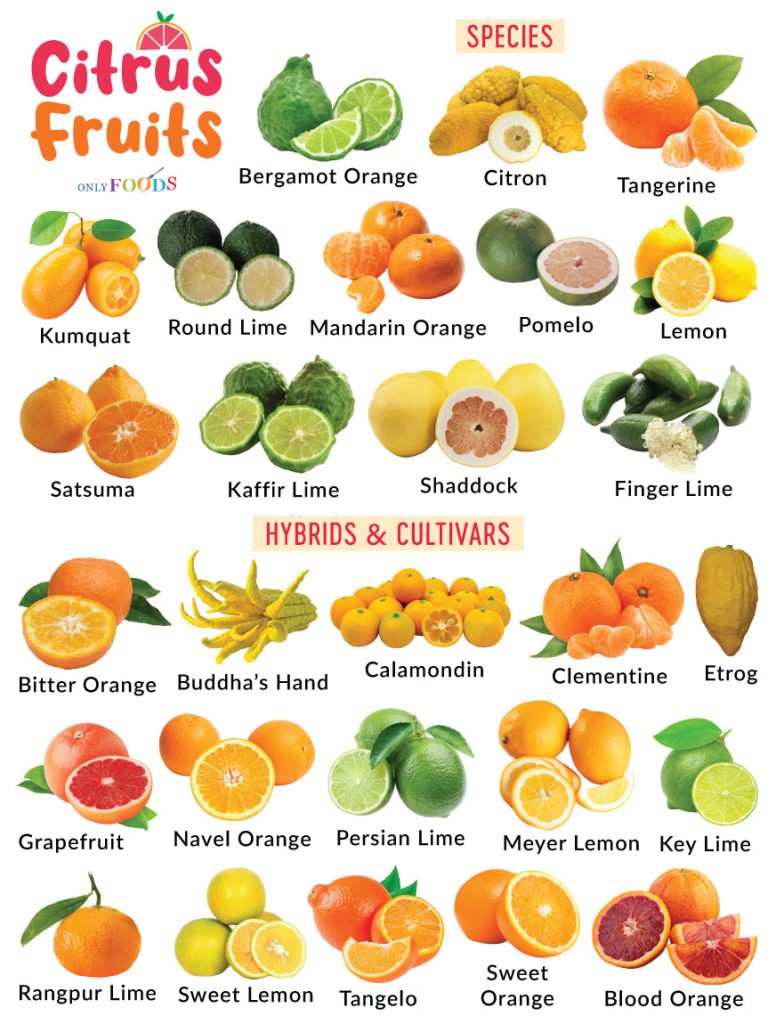Citrus Fruits
Colorful and juicy, citrus fruits easily make the list of the most popular fruits worldwide. Whether eaten raw, used in desserts, or added to savory dishes, they are an irreplaceable part of most cuisines.
To define botanically, citrus fruits are the fruits of plants belonging to the Citrus genus in the Rutaceae family. All of them originate from the tropical and subtropical regions of Asia and central and northeastern Australia.
What Makes a Fruit ‘Citrus’
In addition to sharing the same genus, these fruits also share the following characteristics:
- Excellent sources of citric acid and vitamin C
- Known for their refreshing flavor and tangy taste
- Characteristic juicy texture due to having fruit pulp formed of juice vesicles
- Distinctly aromatic peels that are often used for flavoring
List of Different Types of Citrus Fruits
The group includes some of the best-known fruits like oranges, lemons, and limes. Interestingly, most of the citrus fruits known today are developed as hybrids or cultivars of three original species – the mandarin orange, pomelo, and citron. An orange, for example, comes from pomelo and mandarin orange. The orange itself is then hybridized with pomelo to produce grapefruit.
Here is a list of all the edible citrus fruits, divided based on whether they occur naturally or are grown as hybrids/cultivars:
Citrus Fruit Species
- Citron
- Mandarin Orange
- Pomelo
- Lemon
- Tangerine
- Koji Orange
- Bergamot Orange
- Kumquat
- Clymenia
- Hyuganatsu (Konatsu, New Summer Orange)
- Kabosu
- Kawachi Bankan
- Mangshanyegan
- Myrtle-leaved Orange Tree Fruit (Typically used for Chinotto)
- Shaddock
- Satsuma (Cold Hardy Mandarin)
- Sudachi
- Desert Lime
- Finger Lime
- Round Lime
- Ginger Lime (Adajamir)
- Ichang Papeda
- Kaffir Lime
Hybrids and Cultivars
- Blood Orange
- Bitter Orange (Sour Orange, Seville Orange)
- Navel Orange
- Sweet Orange
- Grapefruit
- Clementine
- Key Lime
- Persian Lime (Bearss Lime, Tahiti Lime)
- Amanatsu (Natsumikan)
- Meyer Lemon
- Tangelo (Honeybell)
- Sweet Lemon (Sweet Limetta, Sweet Lime)
- Calamondin (Calamansi)
- Balady Citron (Israel Citron)
- Buddha’s Hand (Bushukan, Fingered Citron)
- Corsican Citron
- Diamante Citron
- Etrog
- Greek Citron
- Moroccan Citron
- Pompia
- Cam Sành
- Citrange
- Citrumelo
- Iyokan (Anadomikan)
- Florentine Citron
- Haruka
- Hassaku
- Yuzu
- Kinnow
- Orangelo
- Jabara
- Kobayashi Mikan
- Oroblanco
- Volkamer Lemon
- Lumia
- Rangpur Lime (Lemandarin)
- Ponkan
- Shonan Gold
- Tangor
- Kinkoji Unshiu
- Yukouponderosa Lemon
- Shangjuan (Ichang Lemon)
- Taiwan Tangerine
- Kuchinotsu No. 37
- Kiyomi
- Jamaican Tangelo
- Kanpei
Noteworthy Citrus Fruits
| Largest Citrus Fruit | Pomelo |
| Smallest Citrus Fruit | Kumquat |
| Sweetest Citrus Fruit | Mandarin Orange, Tangerine, Blood Orange |
FAQ
Different citrus fruits may be available throughout the year, but typically, they are in season between November and March.
As already mentioned, most of today’s citrus fruits originate from Asia. Pomelo, yuzu, and Meyer lemon are some citrus fruits still cultivated on this continent.
A few examples of citrus fruits with yellow skin are lemon, buddha’s hand, and etrog.
There are no blue citrus fruits.

